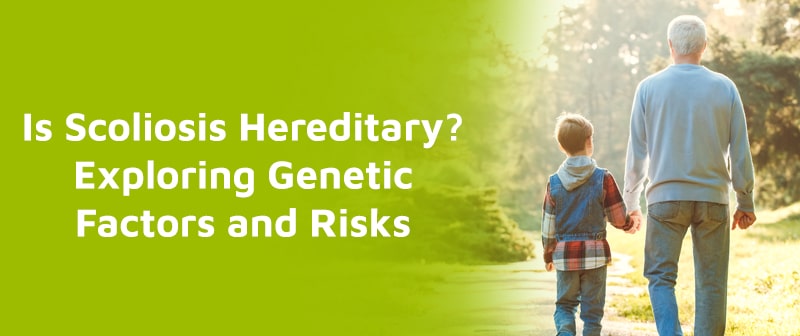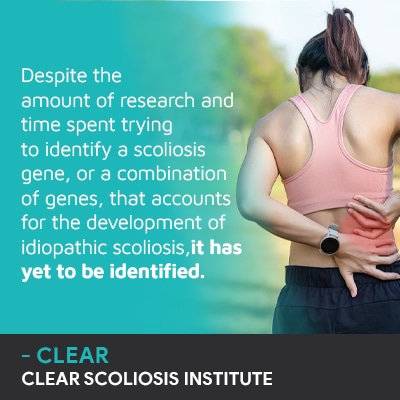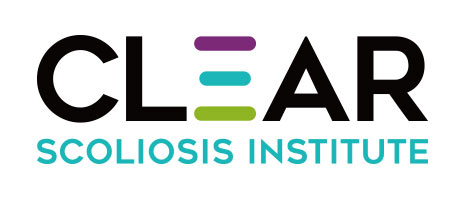
Although having a family history of scoliosis is considered a risk factor, it's still not considered a genetic condition. Idiopathic scoliosis is thought to have some genetic factors, but the truth is that families share a lot more than just genes, so let's explore what that means.
Scoliosis is an ancient spinal condition, but we still don't fully understand what causes its initial development. Despite studies and research, a single gene accounting for the development of scoliosis has yet to be identified; in general, scoliosis is considered familial, not genetic.
It's important to understand that there are different types of scoliosis, and type is determined by causation, so let's start with exploring the four main types of scoliosis.
When scoliosis is first diagnosed, this involves a comprehensive physical examination that includes taking the patient's medical and family history and examining the spine and body when in a forward bend position (spine is highly visible in this position).
To officially diagnose scoliosis, an X-ray is necessary to see what's happening to the spine and its surroundings, to confirm a rotational component, and determine a patient's Cobb angle measurement.
Scoliosis causes the spine to bend and twist unnaturally to the side; to be considered a true scoliosis, the rotation has to be present, along with a minimum Cobb angle measurement of 10 degrees.
A patient's Cobb angle indicates how unnaturally tilted the spine's vertebrae are, how misaligned the spine is, and condition severity:
So the higher a patient's Cobb angle, the more severe the condition, and the more overt its effects are going to be.
Another aspect of diagnosing scoliosis involves classifying conditions based on key factors, one of which is condition type, and condition type is determined by a condition's underlying cause.
The debate over the genetic nature of scoliosis involves idiopathic scoliosis; the remaining types have known causes, so let's start there.
While most cases of scoliosis have an unknown cause, there are three condition types associated with known causes, and these types are considered atypical.
In typical cases of idiopathic scoliosis, curves bend to the right, away from the heart, but in atypical cases of scoliosis, curves can bend to the left, known as levoscoliosis, and this indicates an underlying pathology causing the scoliosis development.
Neuromuscular scoliosis, congenital scoliosis, and degenerative scoliosis account for approximately 20 percent of known diagnosed scoliosis cases.
Neuromuscular scoliosis is caused by the presence of a larger neuromuscular condition such as cerebral palsy, muscular dystrophy, or spina bifida, and although not everyone with a neuromuscular condition is guaranteed to develop scoliosis, it is a common complication, so awareness is important.
Congenital scoliosis is caused by the spine not forming properly in utero, so babies are born with congenital scoliosis, and degenerative scoliosis affects older adults and is caused by natural age-related degenerative changes occurring in the spine.
So atypical types of scoliosis have known causes, but what about the main type of scoliosis?

Not being clearly associated with a single-known cause is not the same as a complete absence of a cause; idiopathic scoliosis is thought to be a multifactorial condition.
Multifactorial conditions are caused by a number of variables, or a combination of certain variables, that can vary from person to person.
What we do understand about idiopathic scoliosis is its progressive nature, meaning it's virtually guaranteed to get more severe over time, especially if left untreated and/or if particularly severe.
Scoliosis progression complicates the treatment process because progression is triggered by growth, so a focus of childhood scoliosis treatment is on how to counteract progression during growth.
The most prevalent type of scoliosis overall is adolescent idiopathic scoliosis, and this condition type affects children between the ages of 10 and 18, and adult scoliosis is diagnosed once skeletal maturity has been reached, which is also when the condition becomes compressive.
Scoliosis is the most prevalent spinal condition among school-aged children, and coupled with the seriousness of its progressive nature, a lot of research and studies have been dedicated to determining whether or not idiopathic scoliosis is hereditary.
Despite the amount of research and time spent on trying to identify a scoliosis gene, or a combination of genes, that accounts for the development of idiopathic scoliosis, it has yet to be identified.
The interesting thing is that having scoliosis in the family increases the likelihood of another member being diagnosed, so if this isn't because of shared genes, why is a family history of scoliosis considered a risk factor?
The answer is that families don't just share genes, they share a lot more, and considering the multifactorial nature of idiopathic scoliosis, it makes sense that familial factors can play a role in its initial development.
Families share genetic factors, but they can also share body type, diet, lifestyle, socioeconomic factors, geography, responses to stress, posture, and more, so strong evidence suggests that idiopathic scoliosis could have some genetic factors, but not enough to be classified as a genetic and inheritable condition.
Research suggests that genetic and environmental factors, along with familial variables, could combine in such a way that the development of idiopathic scoliosis is triggered, and then progression of the condition is triggered by growth spurts.
Twin studies can support both the genetic contributions to the development of idiopathic scoliosis and the familial nature of scoliosis; there are cases where despite sharing the same genes, one twin develops scoliosis while the other does not, or additional cases where one twin develops one type of scoliosis and the other develops a different type, but there are also cases where shared genetic factors play a role in the similarity of curvature patterns and severity in twins.
The bottom line is that we still don't fully understand the pathogenesis of idiopathic scoliosis, and while this is significant, what's more important is how a diagnosis of scoliosis is responded to with treatment.

There are, however, several theories on the pathogenesis of idiopathic scoliosis from low body mass to melatonin deficiency, excessive time spent in chlorinated pools, and upper cervical injury and spinal cord tension.
As the spine's surrounding muscles also play a role in its ability to maintain its natural and healthy curves, there are theories about the role of muscular and/or connective-tissue conditions in the development of scoliosis.
I've had many parents ask if their child's scoliosis was inherited from them during a diagnosis, and while certain genetic factors could predispose a young person to the development of idiopathic scoliosis, concrete proof confirming the heritability of scoliosis has yet to be found.
When it comes to the nature of idiopathic scoliosis, while genetic and environmental influences can play a role in its development, the general consensus is that it's caused by a number of variables that can differ from patient to patient.
The complex nature of idiopathic scoliosis necessitates the complete customization of treatment plans, and while I can never guarantee treatment results, the ability to detect scoliosis early and respond proactively can make treatment success more likely for scoliosis patients.
While fully understanding a condition as prevalent as scoliosis has its benefits, what I remind patients is that whether or not we fully understand scoliosis development, what's more important is that we fully understand scoliosis treatment.
Here at the CLEAR Scoliosis Institute, a proactive conservative chiropractic-centered treatment approach is what patients benefit from, and this means combining multiple scoliosis-specific forms of treatment so treatment plans can be fully customized and apportioned accordingly based on how the spine is responding.
What a scoliosis diagnosis means, regardless of type or severity, is that treatment is needed; regardless of what causes scoliosis to develop, its nature is to get worse over time, so being proactive with treatment is key.
An abnormal curvature of the spine can be highly treatable, particularly with an early diagnosis and intervention.
If there is a history of the condition in the family, the best thing a parent can do is to be diligent with taking their child for regular screening examinations conducted by healthcare professionals, and regularly checking for indicators of the condition, and in child's scoliosis, the earliest signs are often uneven shoulders and hips.
Knowing the early signs of scoliosis can lead to early detection: a factor that can increase the likelihood of treatment success.

CLEAR provides a unique and innovative way of understanding scoliosis. Sign up to receive facts and information you won’t find anywhere else.
